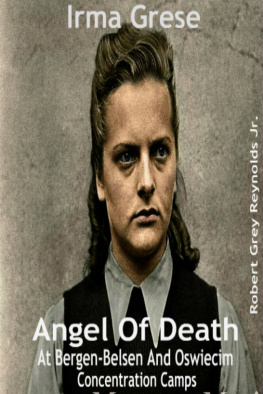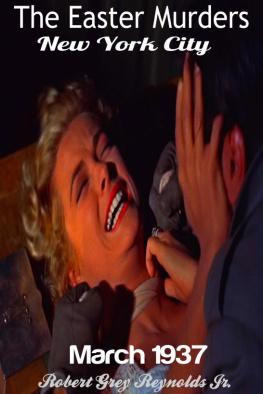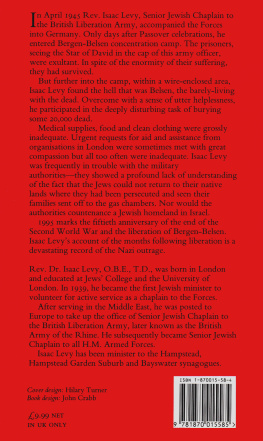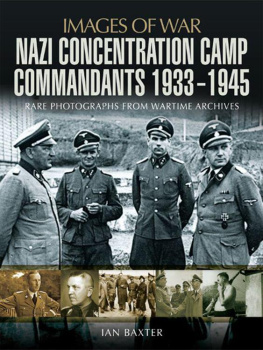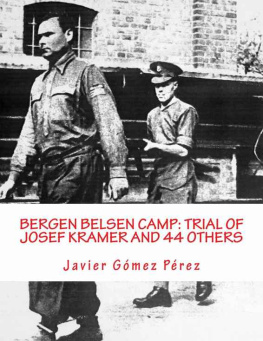Irma Grese
Angel of Death AtBergen-Belsen And Oswiecim
ConcentrationCamps
Published by Robert GreyReynolds Jr. at Smashwords
Copyright 2015 by RobertGrey Reynolds Jr.
Josef Kramer (November 10,1906-December 13, 1945), the former military commandant of Belsenand Oswiecim concentration camps testified before a BritishMilitary Court
on October 9, 1945. He was amongforty-four guards and officials being tried in Lueneburg,Germany.
He completely denied abusingprisoners himself. Of blonde Irma Grese, Queen of Belsen, reputedly the worstof the SS women, he remarked, she took herduties very seriously and discharged them very well.
Kramer denied statementsmade by prosecution witnesses who said that he had beaten andkicked Russian prisoners, and shot and killed twoHungarians. During all my service withconcentration camps and with troops I never shot at peopleintentionally or otherwise.
Questioned by an attorneyfor 21-year-old Irma Ida Ilse Grese (October 7, 1923-December 13,1945) the former commandant denied that she had either shot prisoners or treated them with savage cruelty. Kramer said simply , Thisis untrue. Kramer also refuted thatGrese had turned dogs on prisoners. He reiterated what he had already said about thewoman he supervised, that she took herduties very seriously and discharged them very wellindeed.
On November 17, 1945 JosefKramer, also known as The Beast ofBelsen , attractive Irma Grese, and nineother specialists involved in the torture of prisoners, weresentenced to die by hanging. Their punishment was meted out fortorturing thousands of prisoners who were confined to Belsen andOswiecim concentration camps.
A 53-day trial ended with theconviction of twenty-one more men and women who were given jailsentences that ranged from life to one year. Fourteen of theoriginal defendants were acquitted of the charges againstthem.
The thirty convicted defendants werebrought two by two before the court to hear their sentences read.All except one showed no emotion. A single prisoner fainted. Theprisoners were given forty-eight hours to file appeals to FieldMarshal Bernard Law Montgomery (November 17, 1887-March 24, 1976).It was considered very doubtful that he would act with leniency toany of those who had been convicted of killing prisoners in gaschambers. Leniency was also unlikely for individuals who performedmedical experiments or for persons who melted down bodies togenerate fat for the Nazi was effort.
Aside from Kramer, 39 and Grese, 22,two women and seven men were sentenced to death by the Britishtribunal. They were Dr. Fritz Klein, 58, Peter Weingartner, 30,Franz Hoeszler, Karl Franzich, Ansgar Pichen, Franz Starfle,Elizabeth Volkenrath, Juana Borman, and Wilhelm Dorr.
Dorr was an SS guard, Borman was asmall woman who allowed dogs to attack prisoners, and Weingartnerwas a Yugoslav peasant who was employed at both concentrationcamps. Borman had eschewed missionary work to join theS.S.
Franzich, Pichen andStarfle were also SS guards. Klein was a doctor who selectedprisoners for the gas chambers at Oswiecim. Hoeszler was Kramer'sassistant and helped select victims to die in the gas chamber.Volkenrath was head women's supervisor for the S.S. (Elite Guard).The eight men and three women were assigned to die by Britishmilitary court 17. Major General H.P.M. Berney Ficklin, Presidentof the Lueneberg Court, said afterward that he believed the principles of British justice had been carriedout. The court was adjourned exactly twomonths after the proceedings began.
Born on October 7, 1923, Irma Greseattended public school until 1938. She then left school and workedfor six months doing agricultural tasks on a farm. She also workedin a shop in Lychen, Germany for half a year's time.
At fifteen she attemptedto qualify as a nurse, working in a hospital in Hohenlychen for aperiod of two years. The labour exchange assigned her to work at adairy in Furstenburg instead of retaining her at the hospital. Ather trial Irma testified, I tried twice tobecome a nurse but the labour exchange sent me to the concentrationcamp service.
Like many other German youths IrmaGrese was swayed by Adolf Hitler's oratory. She was also profoundlydismayed by the corruption of the Weimar Republic that precededHitler in power. She had joined a Nazi youth group and avidlyembraced their ideology.
At 19 Irma became a supervisor at theRavensbruck training camp, which was used for years to conditionfemale SS guards. Her tenure there came during the pinnacle of theNazi anti-Jewish programs, in July 1942. In March 1943 Grese wastransferred to Auschwitz concentration camp in Poland. She laterreturned to Ravensbruck before going onto Bergen-Belsen in March1945.
By the fall of 1943 Irma Grese hadascended to the rank of Oberaufseherin (Senior SS Supervisor). Shewas put in charge of 30,000 female prisoners on a day-to-day basis.The majority of these detainees were Polish and Hungarian Jews. Inrank she was the second most senior female guard.
On October 15, 1945 SS female guardIrma Grese testified with her life on the line at the Luenebergtrials in Germany. Her attorney compared the beatings endured byprisoners in Belsen and Oswiecim concentrations camps to beatingincidents in North Carolina.
Major L.S.W. Cranfieldstated in court, The United States ofAmerica cannot be disputed as a leader of civilization. The officerthen read descriptions of floggings inside a North Carolina convict camp. He said, These eventswere judged as crimes. My argument is that condemning of corporalpunishment is not a proper course for a judicial body to take. Thecourt must consider what was reasonable conduct of the personsinvolved-these are not unknown horrors.
Cranfield addressed the court whilerepresenting Irma Grese, Ilse Lothe, Hilda Lobauer, and JosephKlippel. There were forty-four guards on trial with camp commandantJosef Kramer. British officer Cranfield declared that the chargesagainst the concentration camp staff were grossly exaggerated andany evidence is totally unreliable.
The Belsen internees wereravaged with disease, Cranfield explained. The Grese woman was only too anxious to keep her hands off ofthem. Irma Grese testified after hersister, 17-year-old Helena Grese, appeared on the witness stand.Helena remembered their father whipping Irma the last time shecamehome because she had joined theSS.
Irma remained on the standfor several days. She answered numerous accusations that she savagely beat prisoners and shot and killedcamp inmates on four different occasions.Cranfield emphasized that Irma Grese was better looking than the other female accused. It was notsurprising to see the spite andvindictiveness with which they pick on her, he said.
As Cranfield questionedGrese, the young woman spoke in a girlishvoice , one whichbelied her hard face. Cranfield hadattempted unsuccessfully to have an expert in international lawsummoned to court. The attorney wanted this individual to arguepoints of law during the trial.
Prosecutor T.M. Backhousecountered by arguing for regularity-thetime has come to draw the line . He said this after the defenseintroduced Professor H.A. Smith of London University, an academic.Smith wanted to argue that the charges against the concentrationcamp defendants represented no offenseagainst international law.
The court rejected the defense motionafter considering it for forty-five minutes. They concluded bypermitting H.A. Smith to make an address for the defendants afterall evidence had been presented. This was expected to take anadditional two weeks of testimony.
On Monday, September 24,1945 Irma Grese was depicted at the Lueneburg trial as a pistol-packing woman guard who shot two Polish girls as they were attempting to escapedying in the gas chamber. Grese shot them while they were jumpingout of a window at the Oswiecim concentration camp.
Next page
